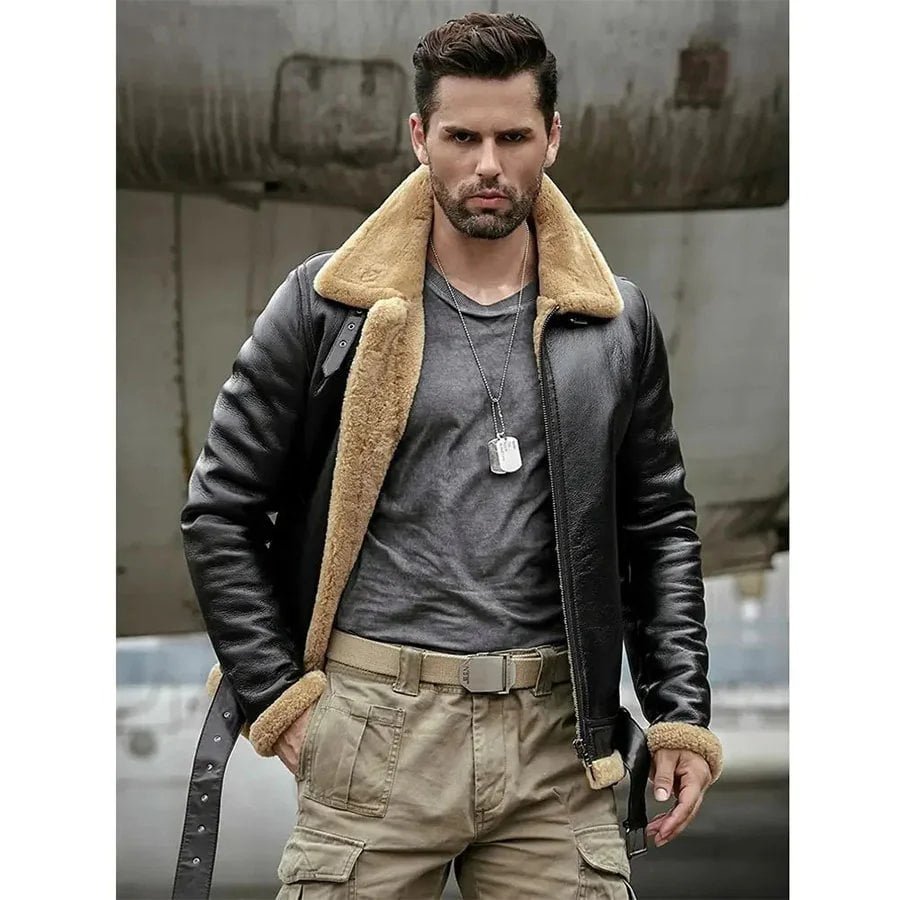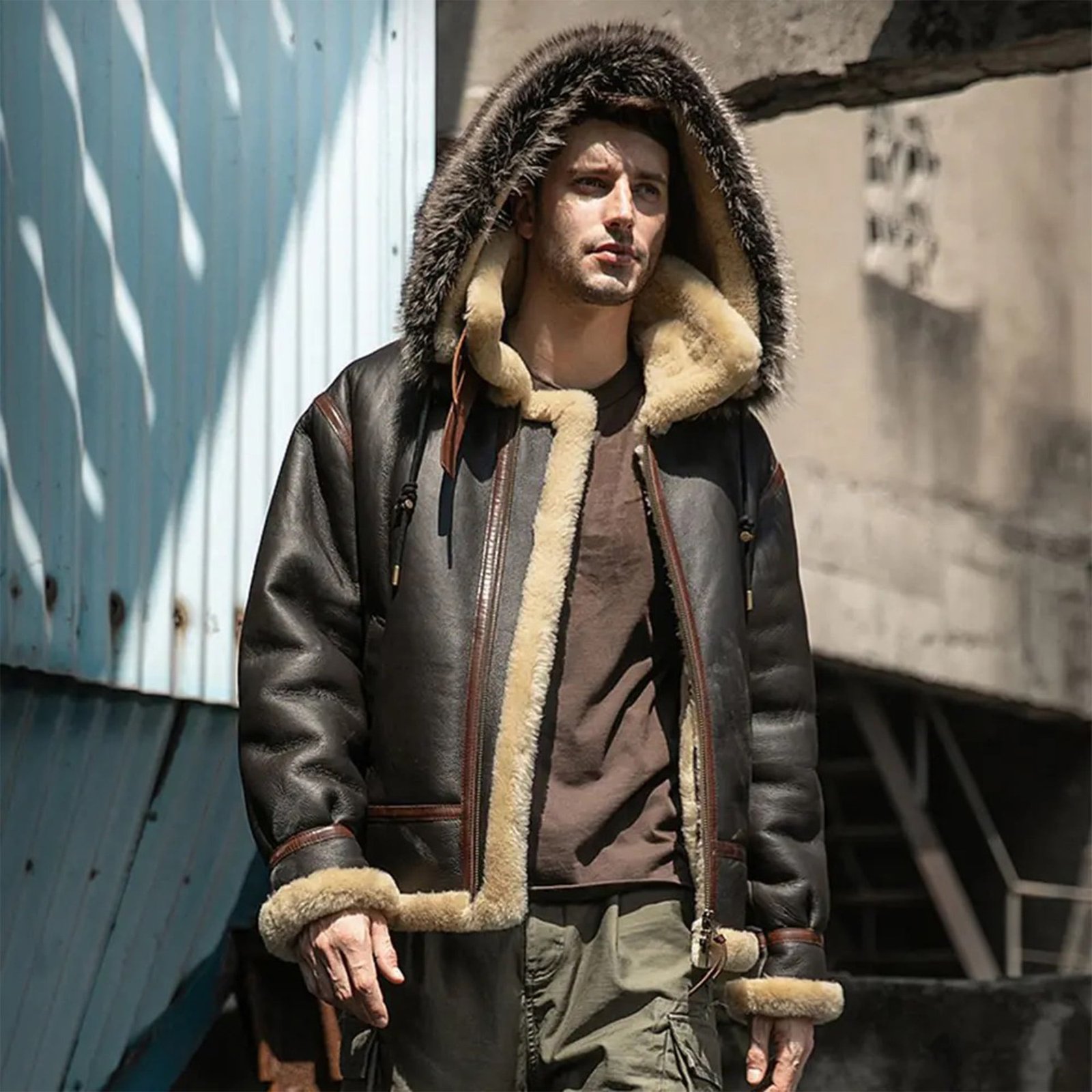The Fascinating Origin of the B3 Bomber Jacket
The B3 bomber jacket, an iconic piece of outerwear, holds a unique position at the intersection of fashion and aviation history. Originally designed for pilots during World War II, its primary purpose was to provide warmth and protection at high altitudes. The jacket’s construction was paramount, utilizing durable materials such as sheepskin and heavy-duty leather to withstand the harsh conditions encountered in unpressurized bomber aircraft.
In the realm of fashion, the B3 bomber jacket has transcended its utilitarian origins to become a timeless symbol of rugged style. Its distinctive features, including the sheepskin lining and leather exterior, have made it a sought-after item for both vintage enthusiasts and contemporary fashionistas. The jacket’s aesthetic appeal lies in its combination of functionality and rugged elegance, which resonates with a broad audience.
This historical significance adds a layer of depth and authenticity to the jacket, making it more than just a fashion statement. Its evolution from a practical garment to a fashion icon reflects a fascinating journey that mirrors broader cultural and technological shifts over the decades.
This exploration will uncover the various factors that contributed to its creation and the enduring appeal that has kept it relevant through generations. The B3 bomber jacket is not merely a piece of clothing; it is a testament to the ingenuity and spirit of a bygone era, seamlessly woven into the fabric of modern fashion.
During World War II, pilots faced a myriad of challenges that extended beyond the obvious dangers of aerial combat. As aircraft soared to altitudes exceeding 30,000 feet, temperatures could plummet to as low as -50 degrees Fahrenheit. These frigid conditions posed significant risks to airmen, potentially leading to hypothermia and frostbite, which could severely impair their performance and jeopardize missions.
The B3 bomber jacket emerged as a critical solution to this problem. Made from sheepskin and lined with shearling, the jacket effectively trapped body heat, offering much-needed protection against the biting cold. The thick, durable exterior also shielded pilots from the wind, ensuring that they could maintain focus and dexterity during crucial operations.
Prolonged exposure to extreme cold could lead to a decrease in cognitive functions, slower reaction times, and overall fatigue. The B3 bomber jacket’s design, therefore, played a vital role in preserving the health and efficiency of airmen, allowing them to execute their missions with precision and confidence.
In addition to its functional benefits, the B3 bomber jacket became a symbol of resilience and ingenuity.The shearling lining, often left natural or dyed, was a critical feature that offered exceptional warmth. This thick, wooly interior ensured that pilots remained comfortable even in the most frigid environments.
The jacket also included heavy-duty zippers and reinforced seams, ensuring that it could withstand the rigors of military use.
Irvin Scott and the Original Design
Scott’s role in the design process was both innovative and meticulous.
Irvin Scott’s contributions to the B3 bomber jacket were not merely functional but also transformative. His design set a new standard for aviation apparel, combining practicality with comfort.
Manufacturing and Wartime Production
Producing the B3 bomber jacket on such an extensive scale posed significant logistical challenges. Manufacturers had to ensure a consistent supply of these materials to maintain production schedules. Additionally, the sheepskin had to undergo a meticulous tanning process to achieve the necessary durability and insulation properties.
Mass production of the B3 bomber jacket also required careful coordination among various suppliers and manufacturers. . Factories often worked around the clock, employing a substantial workforce to meet the ever-increasing demand for these essential garments.
The challenges did not end with production. Distribution logistics were equally complex. This required a well-organized supply chain capable of timely delivery despite the disruptions caused by wartime conditions.
Distribution and Use in the Field
The distribution process was a well-coordinated effort, ensuring that each aviator received a jacket tailored to their needs.
Historical accounts from World War II provide vivid anecdotes of the B3 jacket’s significance in the field. One such account involves Lieutenant James R. Hill, a B-17 bomber pilot stationed in the European theater. Hill recounted that the B3 bomber jacket was not just a uniform accessory but a crucial piece of survival gear.
In addition to its thermal properties, the B3 bomber jacket also had a psychological impact on aircrews. Wearing the jacket became a symbol of camaraderie and resilience among pilots.
Moreover, the B3 bomber jacket’s durability and practicality extended its use beyond the cockpit. Ground crew members, who also faced harsh weather conditions, found the jacket equally beneficial.
Post-War Adaptation and Legacy
Initially designed for aviators braving frigid altitudes, the jacket’s practicality and distinctive look quickly captured the public’s imagination.
In the post-war era, the B3 bomber jacket began to influence mainstream fashion trends.
Throughout the decades, various subcultures embraced the B3 bomber jacket, each adding its unique twist to the garment.
Fashion designers have continually reimagined the jacket, incorporating modern materials and styles while retaining its iconic elements.
Modern Interpretations and Replicas
These replicas often stay true to the original specifications, including the iconic shearling lining and heavy-duty leather exterior. However, advancements in textile technology have allowed for enhancements in durability, comfort, and weather resistance.
In addition to material innovations, contemporary interpretations of the B3 bomber jacket often feature updated fits and styles. While the traditional oversized silhouette remains popular, many designers offer more tailored versions that cater to current fashion trends.
Ultimately, the enduring legacy of the B3 bomber jacket is a testament to its timeless design and adaptability.












